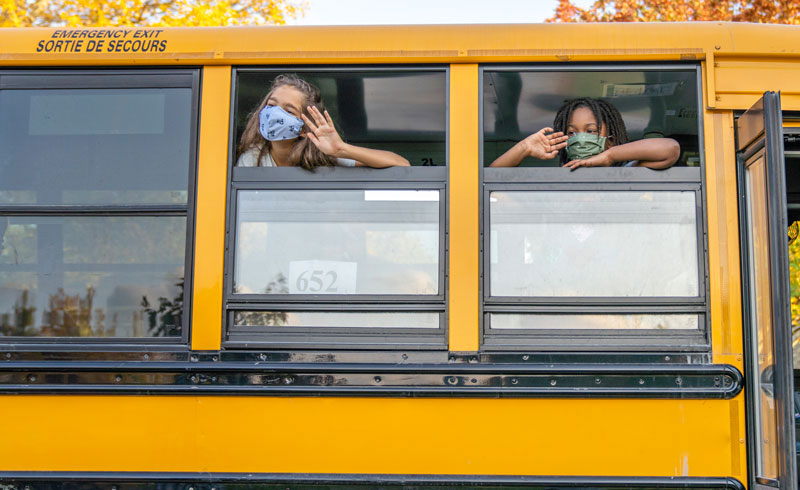What’s the Best Thing Parents Can Do Right Now to Prepare for In-person School?
Last academic year, we saw that with the right science-based measures, children can safely return to school during the COVID-19 pandemic. However, the Delta variant is unlike previous variants for kids, which leads to a bit of uncertainty. We recommend preparing for in-person school in a similar way you would any other year. Here are some ideas:
- Talk about what school may look like for the upcoming year, including the reality that they may need to be out of school if they are sick or that there may be a mix of distance vs. in-person learning.
- Do a “feelings check.” Living through a global pandemic is an exercise in flexibility and adaptability. Take time to listen to your children about worries or uncertainties they may have and praise them for being flexible.
- Take time to assess your own feelings. Staying calm as parents/guardians helps children to feel safe and secure. Reach out the school and/or health care provider if you feel your child may need additional support.
- Routines help children feel calm and prepared. Create routines that work for your family. This may include a fun back-to-school ritual like getting school clothes and school supplies. You may want to visit the school campus, walk around, find drop-off and pick-up points, have a picnic on the school yard or play at the school playground.
- Remember to get adequate sleep. Summer months often come with adjustments in sleep schedule. Plan ahead by helping your child to get to bed early.
- Prepare your school supply lists. Those supplies are typically guided by your child's school district/grade. This year, remember to add masks, hand sanitizer and a water bottle to the list. Practice wearing masks if your children aren’t routinely wearing them now. Kids are adaptable and will adjust well with just a little practice.
- Be prepared to practice patience. It may take some time for your children to adjust back to the school routine and the differences that exist in the school settings this year. This is to be expected. The more stability and safety they feel when at home, the easier it will be for them to adjust to the changes of going back to school.
What if masks are optional at our child’s school?
The American Academy of Pediatrics, Centers for Disease Control and Prevention, and the Minnesota Department of Health all recommend universal masking within schools. Even if masks are optional at your child’s school, we highly recommend children use them in the school setting to reduce risk of disease to your child and reduce spread to others. Masks are one measure to help keep kids back in school and were shown to be excellent at reducing spread within the school setting last year. We will need measures like masks even more this year as the Delta variant is more than twice as contagious as previous variants. For children over 12 years, remember that vaccination is another safe and effective way to help protect children from COVID-19.
How does the Delta variant change things?
The Delta variant is far more transmissible than previous variants. That means that you need less time with someone else who has the disease to be exposed. It is more important than ever to use science-based strategies to help reduce spread. The strategies that have been shown to help reduce the risk of disease for children including distancing, handwashing, masking and vaccination, when able. The use of all these measures together helps more than one alone.
What should parents do if their child gets what seems like a bad cold, but they’re worried it could be COVID-19?
If there is any concern that your child may be sick, we recommend you keep your child out of school and get tested. Testing helps us understand who has COVID, so we can protect the other children who are well and reduce spread.
Should parents test unvaccinated kids regularly for COVID-19?
At this point, there are no current recommendations to suggest routine COVID testing is necessary if your child is not ill.
If there is an exposure, what are my BEST options for testing?
There are two types of COVID tests — molecular and antigen. Because the samples are, for the most part, collected in the same way for both, the differences between the two kinds of tests are largely in how they’re processed. Molecular tests, like PCR tests, have a high-test sensitivity and are therefore the most accurate tests available. They are mostly processed in a laboratory, which takes longer. Antigen tests — which are sometimes referred to as “rapid tests” — are processed pretty much anywhere, including in doctors' offices, pharmacies, or even at home. You can get antigen test results in about 15 minutes, but they are less accurate. Health care providers typically rely on molecular tests like PCR, particularly when people have COVID-19 symptoms. CentraCare’s testing is molecular testing so we can be more confident that a negative result is truly negative.
Do cloth masks offer sufficient protection?
The best mask for any given child is the one he/she will actually wear. So, it’s all about finding what your child will tolerate. Most children are pretty used to wearing masks by now, so they’ll wear whatever you tell them to. But as parents know, when you’re dealing with children, you work within the realm of what’s possible. Face masks with multiple layers of fabric are fine for most people to wear. A medical mask may be recommended by medical providers for some children that are at higher risk of getting seriously ill from COVID. Try to find the right size for your child’s face. Ensure the mask is the correct size and sufficiently covers the nose, mouth and chin of the child.
